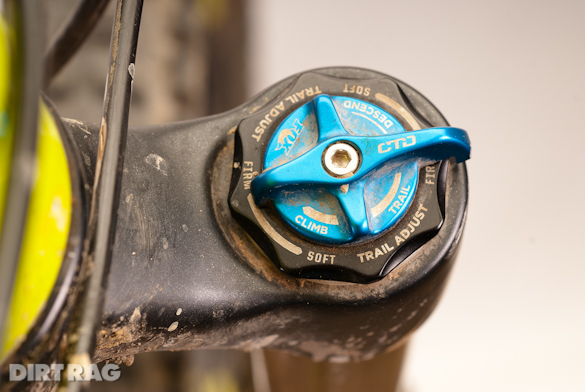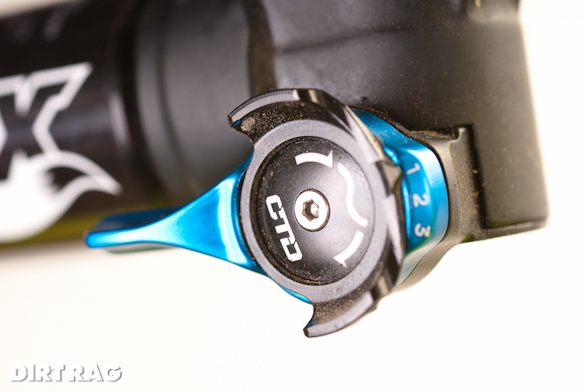Review: 2014 Fox 34 Talas 27.5 and Float X
Originally posted on January 21, 2014 at 9:16 am
For 2014, Fox has significantly revamped its 34-series forks, including a totally redesigned TALAS system, and introduced a completely new shock geared toward all mountain riding and enduro racing.
34 TALAS 27.5 with Trail Adjust – $1,120
While the 34’s chassis remains the same for 2014, nearly all of the internals have been revised. Fox has moved away from the air-operated TALAS system to a new hydraulic version. In doing so, they’ve separated the function of the air spring from the travel adjust mechanism, which allows for a normal, Float-like spring rate in both the longer and shorter travel modes. Speaking of springs, this new TALAS offers a spring curve identical to that of the 2014 Float, which has also undergone revision for 2014—more on that later.
Unlike the old TALAS system, where I didn’t generally like the suspension performance in the short-travel setting, this new version feels just like a Float model of similar travel. According to Fox, this enables the use of TALAS as a climbing feature or a descending feature depending on which fork you choose for your particular bike. In theory, you could install a 150mm-travel fork on your 120mm-travel bike to climb and generally ride in the 120mm mode most of the time while cranking it up to 150mm for the descents.

Additionally, the travel drop of this new TALAS setup can be adjusted in 5mm increments with the addition of spacers under the top of the TALAS cartridge—just unthread the TALAS-side top cap and clip them on. Stock drop is 30mm, so if you put a 5mm spacer in you would only drop 25mm in the short-travel setting. Maintenance has also been simplified, and no longer requires special tools. In total, this system requires fewer seals and yields less stiction than the old system.
In terms of suspension feel, Fox made two big changes for 2014. First, they’ve increased the compression ratio of the air spring, and, secondly, they’ve increased compression damping. Both of these changes have been implemented across the entire 34 line for 2014 in order to provide more support throughout the stroke. Fox listened to feedback from riders who felt the 2013 models were not supportive enough when ridden hard. Subsequently, compression damping has been increased across all settings of the FIT CTD damper. Climb mode is very stiff, feeling nearly locked out even under significant standing efforts. All three of the Trail settings felt similarly firmer, as is Descend mode.

Overall, this is the best feeling TALAS fork I’ve ridden, and a big step forward for the 34 chassis in general in terms of suspension performance. That said, I’m more of a set-it-and-forget-it kind of guy, so I’m not excited to throw a lever, or two, every time the terrain changes. You’re either a TALAS person or you’re not, so it’s good that Fox offers both the Float and TALAS options in the 34 chassis. Good news; old TALAS forks can be retrofitted with this new system.
On the damper side, I’m still not over the moon about the CTD concept despite the improvements. Given some additional low-speed damping in Descend mode, or just a touch more suppleness in the softest Trail setting, I could do without having to switch between them. As it is, I often found myself switching back and forth because neither gave me 100-plus of what I was looking for. Descend still feels a little under-damped and dives more deeply into its travel than I would prefer under braking, cornering and g-outs. The softest Trail setting provides much appreciated support throughout the stroke, but sacrifices small bump performance. For the record, I am splitting hairs here as this fork is a solid performer overall. But, we’re talking about a $1,000-plus product, so it should be damn good. For those riders who appreciate the CTD concept, or those with terrain well suited to the application, this fork is a big improvement over the previous versions. Personally, I’d be happier with an RC2 damper, like you’ll find on the 36 chassis forks, in a 34 Float. Call me a curmudgeon, but I wouldn’t have to flip any levers.
Float X Shock- $575
Fox’s new Float X is the company’s modern take on the outgoing DHX Air, billing it as an “all-mountain shock for aggressive enduro riding.” As such, it’s been designed for bikes sporting 140mm to 180mm of travel.
The DHX Air offered adjustable Boost Valve pressure, bottom out resistance, and rebound damping, while offering a two-position (minimum/maximum) ProPedal switch. The Float X simplifies setup and offers more on-the-fly adjustments by utilizing a new version of Fox’s CTD (Climb, Trail, Descend) damper. This burlier CTD arrangement benefits from the addition of an external reservoir, which accommodates more oil volume to better dissipate heat on long, rough descents. Additionally, a dual valve design—a mid-valve provides additional mid- and high-speed compression support—flows more oil to ensure consistent flow through the dampers. As with the Float CTD, a new large volume eyelet and air sleeve combo is used in conjunction with volume adjust spacers to customize spring rate. For any given bike, the Float X is spec’d with a similar air volume and corresponding compression ratio in order to provide a consistent spring curve.
The Float X’s base valve, located between the shock body and the reservoir, houses the CTD damper unit. When asked about the difference between the Float and Float X CTD dampers, Fox Engineer Bryan Anderson said, “The Float uses a spring loaded poppit valve to generate the trail mode. This starts the compression damping at a non zero force at real low speed and has a “snappier” feel. The Float X generates low speed compression via a metered orifice, which gives a more planted, supple feel.”

In general, the compression tune of the Float X feels a little firmer than its Float counterpart. I swapped out the stock Float CTD on my Santa Cruz Bronson test bike and immediately noticed a more supportive, firmer and planted ride feel in all settings.
Hustling down the trail, the Bronson felt more ready to rumble the rough stuff, and resisted bottom out better with the Float X. In general, it had a more muted and composed feel that provided more of a “gravity bike” vibe. However, with the stock Float onboard, the Bronson felt a little more lively and scooted down the trail with a snappier ride feel. However, once you started pushing harder and faster, hitting larger drops, jumps and g-outs, the Float X provided a more controlled ride.
Unlike the fork, I felt quite content to roll the Bronson’s Float X around in Descend mode often. This is largely due to the efficiency of the Bronson’s suspension. On a bike like the Specialized Enduro 29 I recently tested, I would have likely employed the Trail setting more often. Generally, you can get away with running less damping on suspension designs with more anti-squat. That said, Trail mode—even the softest setting—felt very efficient without sacrificing too much small bump performance, and was good for putting down power. Like the fork, Climb mode is very stiff. I ran Climb only on pavement, where you can really hammer with minimal suspension movement. Off-road, Climb mode negates much of the traction advantage provided by suspension.

Overall, my one issue with the Float X is the rebound adjuster. Due to the packaging constraints of the reservoir, a 2mm Allen key or other similarly small tool must be used to adjust rebound settings. It’s not a big deal, but we’ve become accustomed to tool-free rebound adjustments.
For its intended use, the Float X is a stellar performer. If you’re really pushing your bike, you will appreciate the X’s increased control on the big stuff. If you’re a trail rider with a wheels-on-the-ground riding style, however, you may not realize the full benefits of the Float X. If you’re pushing the limits of your Float shock or looking to upgrade your old DHX Air, the $575 price tag will be well worth the investment.
